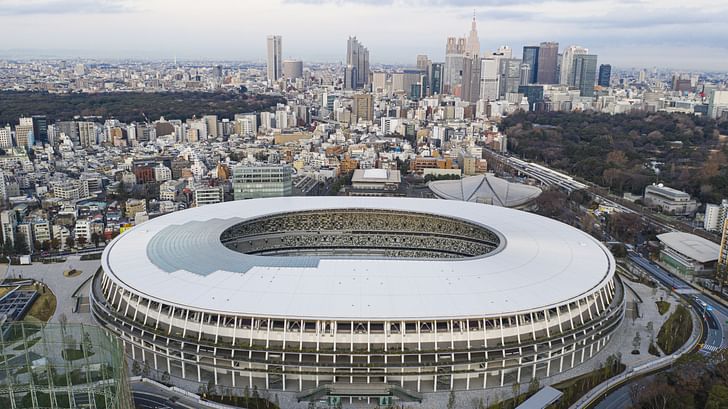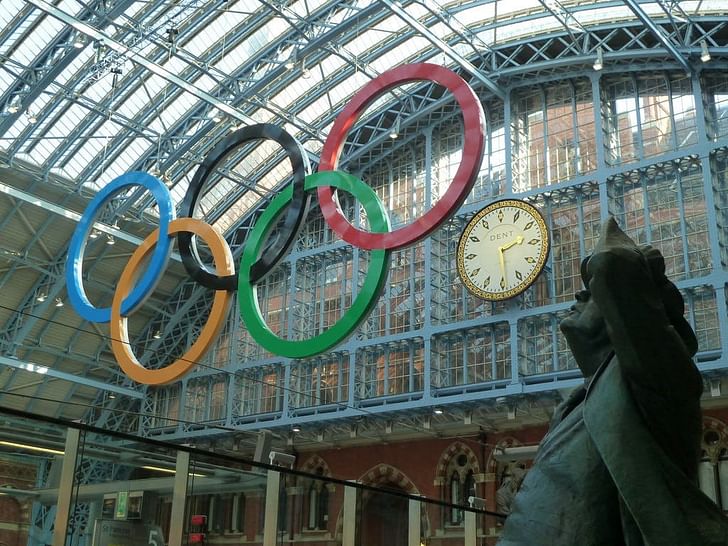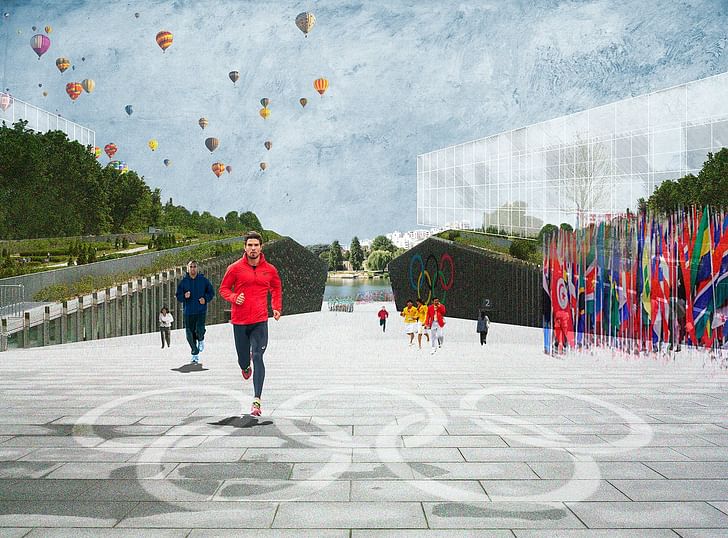

With the 2020 Olympics underway in Tokyo, we reflect on the urban and environmental impacts of the Olympic Games on its host cities. Whether Rio 2016, Tokyo 2020, Paris 2024, or Los Angeles 2028, the Olympics suffer from a legacy of fragmenting existing urban environments, accelerating gentrification, and alienating local citizens. Meanwhile, the environmental cost of hosting the Olympics, driven by the construction of new venues and infrastructure, serves as a visible embodiment of our failure to adequately address climate change. Among the challenges, however, there are meaningful steps for improvement.
The fact that the 2020 Olympic Games commenced midway through 2021 is a sign of the times. Like any event with a traditional ethos of international gathering, Tokyo 2020 was postponed due to the COVID-19 pandemic, beginning almost exactly one year after originally planned. While the Olympics are once again underway, the unique impact of the pandemic remains clear: an absence of spectators, a social separation between those involved in the Olympics and the wider city, and a slew of last-minute dropouts by athletes testing positive for COVID-19 on the eve of the event.
The experience of watching the Olympics in 2021 is unique, but the familiar debate surrounding the impact of the Games on the urban, social, and climatic fabric of the host city is unchanged. While some observers marvel at Kengo Kuma’s cedar-clad National Stadium forming the centerpiece of the Games, critics point to the urban upheaval caused by the stadium’s construction. In a 2017 paper titled The right to adequate housing: evictions of the homeless and the elderly caused by the 2020 Summer Olympics in Tokyo, a group of academics from universities in Tokyo detailed the expulsion of dozens of homeless people who lived in and around the stadium grounds and the “sudden decision to demolish a nearby public housing estate built for the 1964 Summer Games that forced over 200 tenants, most of whom were elderly, to be relocated.” According to one study, the 2020 Olympics has displaced more than 500 people due to new construction.
Beneath a veneer of sustainability, critics say that the processes used to construct the 2020 Olympics have serious environmental consequences.
Tokyo 2020 has also been subject to the same environmental scrutiny as previous Olympics. Despite the Games’ slogan “Be better, together —For the planet and the people,” critics have expressed frustration that the sustainability agenda of Tokyo 2020, while an improvement on previous Games, amounts to insufficient greenwashing. In a first-of-its-kind study on the environmental impact of the Olympics Games, a group of researchers from the University of Lausanne found that the 2020 Games will be the third-least sustainable since 1992. “No one wants to say goodbye to the Olympics,” says Sven Daniel Wolfe, one of the study’s authors speaking to the UK Independent. “But what we’d like to see is Games that are less injurious, and more fun for everyone, for the hosts, cities, residents, and the environment. Until we address the underlying business model of these events, real sustainability will remain a dream.”

On a surface level, Tokyo 2020 exhibits several environmental accolades. The extra electricity required to power the Games is 100% renewable energy, while carbon dioxide-free hydrogen is being used as fuel for Olympic torches and cauldrons. A zero-emissions transport fleet across the Games includes fuel-cell electric buses, battery shuttles, and hydrogen-powered trucks, while recycled materials in the Games include podiums made from recycled plastic, and athlete accommodation using recyclable cardboard beds. Beneath this veneer of sustainability, however, critics say that the processes used to construct the 2020 Olympics have serious environmental consequences. Kengo Kuma’s National Stadium has been subjected to particular scrutiny, with the Rainforest Action Network (RAN) claiming that the 120,000 sheets of Indonesian plywood used as formwork for the building lacked any certification of sustainability. "We actually found that the majority of the Indonesian plywood that the Olympic organizers sourced was coming from rainforests that are being converted into palm oil plantations," RAN campaigner Hana Heineken told NPR. Noting that the stadium’s construction has come at a “terrible cost of habitat loss for orangutans and other critically endangered species, along with massive human and workers’ rights abuses,” she asks: “What was all this for? Was it worth it to destroy the rainforests in Indonesia? Our view is: this was a real waste."
While between $10 billion and $12 billion was spent on hosting the 2016 Olympics, only 15 of the 27 venues commissioned for the Games have seen further events since 2016, with the rest sitting abandoned.
Tokyo 2020 isn’t the first Olympic Games to raise questions of the event’s impact on local communities, urban fabrics, or the environment; and it won’t be the last. The chronic impact of the Rio 2016 Olympic Games has been well documented, with over 22,000 households being displaced to make way for the event; a number nonetheless dwarfed by the 1.5 million evictions in advance of the Beijing Olympics in 2008. “For the most part, they now live in worse situations than they did before,” the head of a Rio-based NGO told The Guardian. “And these were already the poor in a very unequal city.” While billions of dollars, and 20% of evictions, were spent on new transport infrastructure, urban mobility within the city has in fact declined in the Games’ aftermath. “Rio 2016 leaves a shady legacy of a city entrenched with marginalization and discrimination, with a deeply militarized public security approach and a record of human rights violations, where violence remains part of the game,” says an Amnesty International report which examined the impact of the Rio 2016 Games on the city. “Unfortunately, the promised legacy of the Olympics of achieving a safe city for all people was not delivered, and instead a legacy of human rights violations endures.”
While between $10 billion and $12 billion was spent on hosting the 2016 Olympics, only 15 of the 27 venues commissioned for the Games have seen further events since 2016, with the rest sitting abandoned. Within six months of the Games, the central Maracana Stadium was looted, with windows smashed, copper wire stolen from walls, 10% of seats torn up, and an eventual disconnection of the stadium’s electricity. The Games’ purpose-built golf course suffered a similar fate, embroiled in financial trouble due to a lack of use. The $20 million facility was constructed despite the fact that the city already offered two elite courses and was ultimately built away from the Games’ hub near a working-class suburb, in favor of a wealthy suburb to the west, and despite its impact on an ecologically sensitive area. Meanwhile, owners of the 800,000-square-meter athletes’ village abandoned plans to repurpose the area as public housing due to unaffordable prices for local residents, opting instead to provide low-rate loans to sell the accommodation to state entities such as the navy and army. Despite tiresome promises of regeneration and tourism income that accompany the sales pitch of prospective host cities, the 2016 Olympics has taken life from bad to worse for Rio’s low-income residents and their urban surroundings.
Video via Business Insider on YouTube
The disruption to a city’s urban fabric before and after the Olympics is compounded by the changing nature of the city during the Games themselves. In their study of the impact of the Olympics on local livelihoods, researchers from the University of Surrey and Coventry University in the UK note that the restructuring of movement within a city during the Olympics can impact negatively on local businesses. These local enterprises often have “no access to the tourists to begin with, because of the way the city is reorganized during the actual events,” said the study’s authors Mike Duigan and Adam Talbot. “Official sports and cultural activity take place in purpose-built zones, to which the International Olympic Committee (IOC) offers exclusive rights to mega-corporation sponsors, supporters and suppliers. Visitors are encouraged to stay within these zones. They are shuttled between them by an Olympic transport network that effectively shrouds the city and excludes the local community. Not only does this disrupt residents’ day-to-day lives, it reconfigures the city in a way that displaces the existing population.”
Looking to future iterations of the Games, past appears to be prologue.
Looking to future iterations of the Games, past appears to be prologue. As Paris prepares to host the 2024 Olympics, the disruption to existing urban fabrics, and the livelihoods they host, is once again underway. As Duigan and Talbot note, residents and businesses in northern Paris’ impoverished suburbs have been told they must move elsewhere to allow construction of the 2024 athletes’ village. Community buildings to be lost include three schools, two apartment blocks, a hotel, a hostel housing 300 migrant workers, and 19 businesses employing 1,000 people. Meanwhile, according to French news outlet France24, a local engineering school will be “cut in two” by the Olympics by an internal road set to be opened up to traffic, while its student residence and refectory are earmarked for demolition. “France lacks specialized engineers,” the school’s director told France24. “We need to develop the school, and this is more important than this wretched property operation.” Among other proposed works, a new motorway exit is due to be constructed next to another school in the area, leading to concerns from locals that the new infrastructure will see an upsurge in pollution and traffic. One resident told France24: “We should be the main winners of these urban transformations, but at the moment, we are a bit on the losing side in terms of pollution.”

This unease is also taking root within communities due to be impacted by the 2028 Olympics in Los Angeles. “For the Olympics, [what’s] going to drive people to be displaced out of rent-stabilized housing is the construction of new hotels, which are being built in now-gentrifying neighborhoods around Olympic sites in downtown and South L.A., which are predominantly communities of color,” NOlympics L.A. organizer Gia Lappe told Teen Vogue. In March 2021, NOlympics L.A were one of several organizations to join protests at L.A.’s Echo Park, as police sought to remove homeless people as part of the Games’ planning stage. “The removals need to be seen through the lens of how the city is leading up to the 2028 Olympics—that these supposed eyesores of shantytowns and ‘undesirables’ need to be cleared out,” activist Hamid Khan told The Nation. “This is obviously what gentrification and over-policing produces. But it is also the result of how Los Angeles is looking to further brand itself as a ‘destination city’ for events like the Olympics.”
Conscious of the growing discontent among local residents of host cities, and hesitance of city officials to host the Games to begin with, the International Olympic Committee (IOC) has set out a vision for the future of the Olympics titled “The New Norm.” Among the plans, which will be used to select host cities for future Games, the IOC will seek to re-examine Olympic Village models to reduce their size and impact. Venue sharing will also be encouraged to decrease the number of new facilities needing to be constructed for the Games. The IOC points to Los Angeles’ commitment to not construct any new venues for the 2028 Games as a model for the future.
Our analysis shows that organizing more sustainable Olympic Games is possible.
The University of Lausanne’s study on the environmental impact of the Games also sets a tone of optimism, underneath its banner warning that the Olympics appear to be becoming more unsustainable over time despite growing global concern for climate change. “Our analysis shows that organizing more sustainable Olympic Games is possible,” the study notes. “Yet incisive reforms are required to up the game in Olympic sustainability before these events can inspire and influence sustainable futures.” The study points to three key actions which are feasible in the short term but would result in major improvements in sustainability. A significant downsize of the event will “lead to a gain on almost all sustainability indicators by reducing resource requirements” while also reducing the displacement and disruption to people and cities. Meanwhile, rotating the Olympics across a select group of cities would allow for the reuse of infrastructure from previous Games. Los Angeles’ commitment to not construct any new venues for the 2028 Games, for example, is made easier by the fact that Los Angeles hosted the Olympics in 1984. Finally, the report calls for an improvement to sustainability governance, defined as “creating or mandating an independent body to develop, monitor, and enforce credible sustainability standards.” Such a move would prevent individual host cities from setting their own sustainability goals, for which they often remain unaccountable.
An Olympic Games for the 21st century that embraced boundary-pushing environmental and urban responsibility in all its forms, including its architecture, could become a primary vehicle in setting a global sustainable outlook.
Notwithstanding the uneasy environmental, urban, and social upheavals caused by the Olympic Games, the event nonetheless offers a rare embodiment of optimism, global cooperation, and a celebration of the limits of human potential. Reform of the sustainability and urban agenda of the Olympics therefore represents an opportunity for improvement on two wavelengths. At the pragmatic scale of the event, an embrace of proposals such as those from the University of Lausanne would serve to meaningfully reduce the impact of each individual iteration of the Games; principles which could be translated across an array of events within and beyond the sporting world. However, an effective response to climate change must go beyond the pragmatic, organizational, or bureaucratic. In tandem, it must also activate the human consciousness on an everyday, individual level; merging the top-down processes of governments, architects, and urban planners with a bottom-up behavioral responsibility of everyday citizens, their habits, and their consumption of resources.
A rare recurring platform that captures the world’s gaze and its imagination, the spectacle of the Olympics can aid the setting of a more sustainable, equitable agenda; one with potential benefits far beyond the metrics of any one iteration of the event. An Olympic Games for the 21st century that embraced boundary-pushing environmental and urban responsibility in all its forms, including its architecture, could become a primary vehicle in setting a global sustainable outlook. By contrast, an Olympic Games that continues its present losing streak of urban upheaval, material waste, and exploitation will become increasingly toxic in the eyes of once-eager host cities, and their once-inspired residents.
Niall Patrick Walsh is an architect and journalist, living in Belfast, Ireland. He writes feature articles for Archinect and leads the Archinect In-Depth series. He is also a licensed architect in the UK and Ireland, having previously worked at BDP, one of the largest design + ...
No Comments
Block this user
Are you sure you want to block this user and hide all related comments throughout the site?
Archinect
This is your first comment on Archinect. Your comment will be visible once approved.